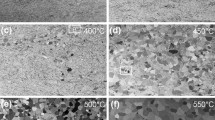Abstract
An analysis of tantalum ingot cold-rolled and annealed under different conditions reveals several correlations between the microstructure, developed textures and thermomechanical processing parameters. For example, the hardness of rolled sheet is not significantly affected by the amount of reduction prior to the final anneal, while the final grain size decreases with an increasing number of intermediate annealing steps. Four classes of texture are found in the cold-rolled tantalum, but the finer-grained classes can only be produced via a 70 percent reduction in thickness prior to the final anneal. Although ample dislocation debris is produced by the rolling operation, clearly defined line dislocations and dislocation networks are absent, indicating that full recrystallization is not achieved in the finished sheets. A large concentration of ledge dislocations at the grain boundary regions is considered an important contributor to the good formability of tantalum.
Similar content being viewed by others
References
T.K. Chatterjee and C. Feng, “Defect Structure and Mechanical Twinning in Rolled and Annealed Tantalum,”EMSA45th Annual Meeting Proc., ed. G.W. Bailey (S n Francisco: San Francisco Press, 1987), p. 234.
L.G. Schulz, “A Direct Method of Obtaining Preferred Orientation of a Flat Reflection Sample Using a Geiger Counter X-ray Diffraction Goniometer,” J. Appl. Phys., 20 (1949), p. 1030.
J.J. Klappholz, S. Waxman and C. Feng, “A Computerized Technique of Plotting a Complete Pole Figure by an X-ray Reflection Method,” Adv. X-ray Anal., vol. 15 (1972), p. 365.
S.L. Lopata and E.B. Kula, “Quantitative Phase Analysis in Textured Materials,” Trans. TMS-AIME, 233 (1965), p. 288.
R.A. Vandermeer and J.C. Ogle, “Texture Inhomogeneities in Cold-Rolled Niobium,” Trans. TMS-AIME, 245 (1969), p. 1511.
F. Witt, “Device for Automated Pole Figure Determination,” Siemens Review, special issue, XLI (1974), p. 59.
C. Feng, “Determination of Relative Intensity in X-ray Reflection Study,” J. Appl. Phys., 36 (1965), p. 3432.
E. Tenckhoff, “Defocusing for the Schulz Technique of Determining Preferred Orientation,” J. Appl. Phys., 41 (1970), p. 3944.
C.K. Chow, “A New Method for Determining the Defocusing Correction For Crystallographic Texture Measurement,” Met. Trans., 16A (1985), p. 299.
R.A. Vandermeer and W.B. Snyder, “Recovery and Recrystallization in Rolled Tantalum Single Crystals,” Met. Trans., 10A (1979), p. 1031.
A.S. Keh and S. Weissmann, “Deformation Substructures in B.C.C. Metals,” Electron Microscopy and Strength of Crystals (N w York: Interscience/John Wiley & Sons, 1962), pp. 573–592
Y. Nakayama, S. Weissmann and T. Imura, “Substructure and Dislocation Networks in Tungsten,” Direct Observation of Imperfections in Crystals (N w York: Interscience/John Wiley & Sons, 1962), pp. 231–300.
H. Hu, “Annealing of Silicon Iron Single Crystals,” Recovery and Recrystallization of Metals (N w York: Interscience/ John Wiley & Sons, 1963), p. 311. See also discussion by J.L. Walter, ibid., p. 364.
H. Hu, “Microbands in a Rolled Si-Fe Single Crystal and Their Roles in Recrystallization,” Acta Met., 10 (1962), p. 1112.
H. Hu, “Reply on Comments by J.L. Walter and E.F. Koch,” Acta Met., 11 (1963), p. 1000; see also comments by J.L. Walter and E.F. Koch, ibid., p. 999.
J.L Walter and E.F. Koch, “Electron Microscopy Study of the Structures of Cold Rolled and Annealed (100)[001] Crystals of High Purity Silicon Iron,” Acta Met., 10 (1962), p. 1059.
J.L. Walter and E.F. Koch, “Substructures and Recrystallization of Deformed (100)[001] Oriented Crystals of High Purity Silicon Iron,” Acta Met., 11 (1963), p. 923.
J.L. Walter and E.F. Koch, “The Effect of Silicon on the Substructure of High Purity Si-Fe Crystals,” Trans. TMS-AIME, 233 (1965), p. 1209.
L.E. Murr, “Some Observations of Grain Boundary Ledges and Ledges as Dislocation Sources in Metals and Alloys,” Met. Trans., 6 (1975), p. 507.
J.C.M. Li and Y.T. Chou, “The Role of Dislocations in Flow Stress-Grain Size Relationship,” Met. Trans., 1 (1970), p. 1145.
R.O. Williams, “The Representation of the Textures of Rolled Copper, Brass and Aluminum by Biaxial Pole Figures,” Trans. TMS-AIME, 242 (1968), p. 105.
G. Ibe and K. Lucke, “Growth Selection During Recrystallization of Single Crystals,” Recrystallization, Grain Growth and Texture (Metals Park, OH: ASM, 1965), p. 434.
D.O. Hobson, J.O. Stiegler and C.J. McHargue, “Twinning in Nb-V Alloys,” Trans. TMS-AIME, 233 (1965), p. 1138.
F.M.A. Carpay, G.Y. Chin, S. Mahajan and J.J. Rubin, “Contained Deformation of Molybdenum Single Crystals,” Acta Met., 23 (1975), p. 1473.
F.M.A. Carpay, S. Mahajan, G.Y. Chin and J.J. Robin, “The Correlation of Textural and Microstructural Changes in Deformed Molybdenum Single Crystals,” Acta Met., 25 (1977), p. 149.
I.L. Dillamore and W.T. Roberts, “Rolling Textures in FCC and BCC Metals,” Acta Met., 12 (1964), p. 281.
J.W. Pugh and W.R. Hibbard, “Rolling Textures in Tantalum,” ASM Trans., 48 (1956), p. 526.
R.A. Vandermeer and J.C. Ogle, “The Development of Preferred Orientations in Cold Rolled Niobium,” Trans. TMS-AIME, 242 (1968), p. 1317.
R.A. Vandermeer and J.B. Bernai, “Deformation Zone Geometry and Texture Gradients in Cold Rolled Niobium,” Textures of Crystalline Solids, vol. 2 (Gordon and Breach Sci. Pub., 1977), pp. 183–203.
R.A. Vandermeer and J.C. Ogle, “The Development of Rolling Texture in a Nb-40%V Alloy,” Met Trans., 1 (1970), p. 1461.
H. Hu, R.S. Cline and S.R. Goodman, “Deformation Textures of Metals,” Recrystallization, Grain Growth and Textures (Metals Park, OH: ASM, 1966), pp. 295–366.
S. Mahajan, “Interrelationship Between Slip and Twinning in BCC Crystals,” Acta Met., 23 (1975), p. 671.
J.C. Ogle and C.J. McHargue, “The Annealing of Deformation Twins in Nb,” Trans. TMS-AIME, 236 (1966), p. 686.
Author information
Authors and Affiliations
Rights and permissions
About this article
Cite this article
Feng, C., Kumar, P. Correlating microstructure and texture in cold-rolled Ta ingot. JOM 41, 40–45 (1989). https://doi.org/10.1007/BF03220361
Issue Date:
DOI: https://doi.org/10.1007/BF03220361




